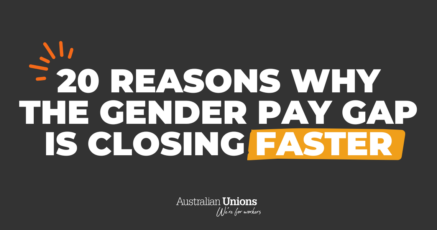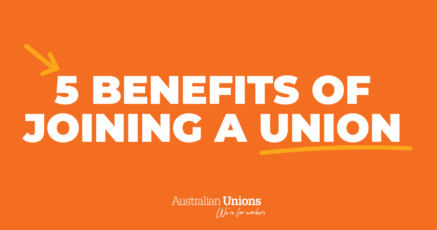Even though we’ve started to see some progress, the gender pay gap in Australia has hung around 15-18 per cent for two decades, and recently, it grew even larger.
Gender pay equality requires a valuing of skills, responsibilities and working conditions that results in workers being paid the same amount for performing the same roles, regardless of gender.
However, this is not the case in Australia, where the average man earns $264 more per week than the average woman.*
The gender pay gap is caused by three main factors:
- the historical undervaluation of feminised work that has led to lower wages in female-dominated industries
- gender discrimination in the workplace
- the ‘motherhood penalty’ that results in women’s wages dropping to less than half in the five years after childbirth.
The Secure Jobs, Better Pay Bill proposes a number of overdue improvements to industrial relations, with a significant focus on the working lives of women. Addressing a broken system through multi-employer bargaining is one of the key strengths of the bill.
According to ACTU President Michele O’Neil, the bill will make it simpler, cheaper and easier for women across the economy to fight to close pay gaps – and multi-employer bargaining is a critical part of this.
The causes of the gender pay gap are fairly well understood, but what is less well-known is the substantial contribution collective bargaining can make to reducing the gap.
How will multi-employer bargaining help close the gender pay gap?
Multi-employer bargaining is a form of collective bargaining where employees across different workplaces in the same industry can strike multi-enterprise agreements and score bigger pay rises. Access to multi-employer bargaining is crucial in ‘feminised’ industries – such as childcare and aged care – where wages are lower.
Collective bargaining can help reduce the pay gap by removing the secrecy around pay scales, delivering targeted pay increases to compensate for the undervaluation of women’s work, and removing barriers for women in the workplace through the right to request flexible working arrangements.
Women on collective agreements earn $102 per week more than women who are not, and workplaces with collective agreements have lower gender pay gaps than those without.
Multi-employer bargaining contributes to gender equality by raising wages in female-dominated industries: this is evident in countries overseas that show a direct correlation between higher levels of multi-employer bargaining and lower gender pay gaps.
The Secure Jobs, Better Pay Bill will help accelerate gender equity in the workplace through multi-employer bargaining and giving the power back to working women.
We know we can achieve amazing things for workers when we come together. That’s why we need as many people as possible to send a message to their senators.
Working women literally can’t afford to wait any longer.
*WGEA is the source of statistics on the gender pay gap. It is important to note the gender pay gap information they publish is specifically on a “female-male” binary. Unfortunately, they do not possess the legal power to publish gender pay gap information relating to the collection of non-binary data.







SHARE:
Multi-employer bargaining accelerates gender equality in the workplace